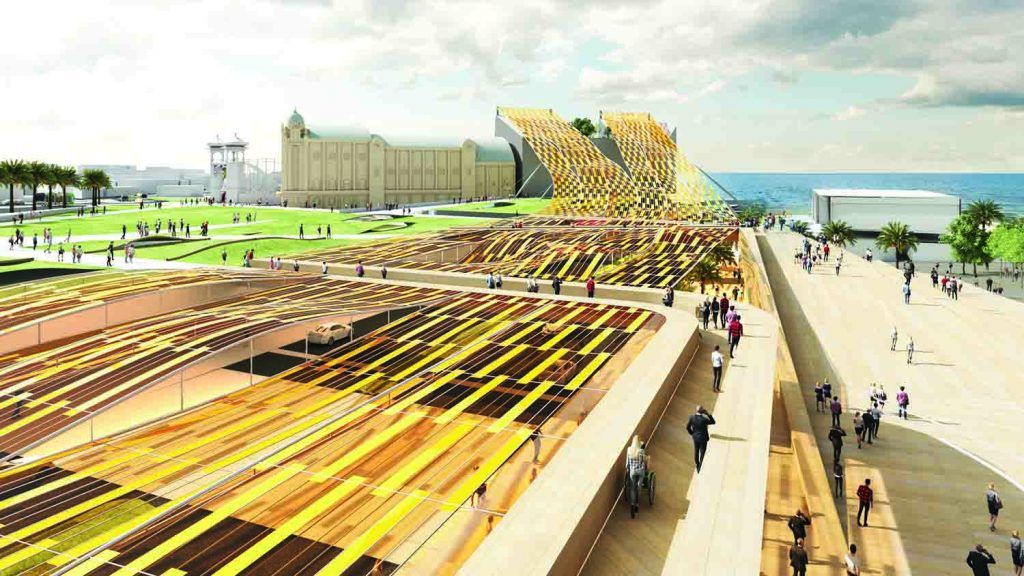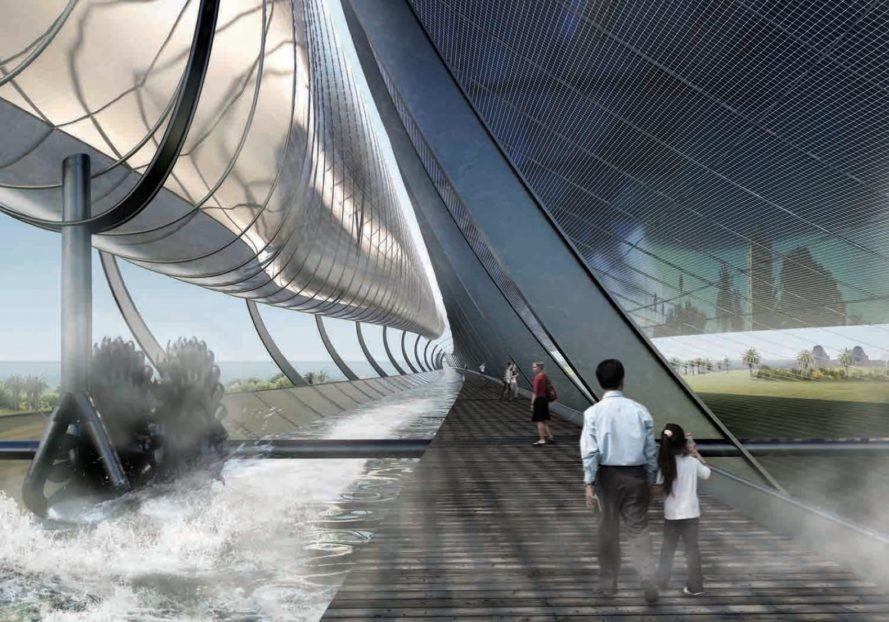This Golden Canopy Could Power 500 Homes
Architects propose a new sustainable landmark on a Melbourne beach that is both public art and a power plant
/https://tf-cmsv2-smithsonianmag-media.s3.amazonaws.com/filer/9a/58/9a587a52-8fa5-4f5c-a3db-175b67844588/lightup-1-lagi-2018-1024x576.jpg)
In the rendering, the structure looks like an enormous golden wave, spilling from the Upper Esplanade of Melbourne’s St Kilda Beach, crossing a busy road and crashing onto the sand. In reality, it would be a canopy of nearly 9,000 flexible photovoltaic panels designed to connect a shopping and entertainment district with the beach while generating renewable energy.
Called “Light Up,” the proposal is the winner of a contest sponsored by the Land Art Generator Initiative (LAGI), an organization whose goal is to “accelerate the transition to post-carbon economies by providing models of renewable energy infrastructure that add value to public space, inspire, and educate.” They’ve been hosting biannual competitions for green energy-generating public art since 2010. Each contest has been centered on a different location—a Copenhagen shipyard, a Dubai desert road, a Santa Monica waterfront—that presents an urban design challenge.
The challenge for the Melbourne competition involved creating a sense of cohesion for the “St Kilda Triangle,” an area bounded by a hilltop market area, busy Jacka Boulevard and an entertainment district containing a historic theater and the city’s iconic Luna Park amusement park, all adjacent to the popular beach. The area, which is pedestrian-unfriendly, harshly sunny and blighted with an ugly sprawling parking lot, has been a topic of redevelopment debate for years.

"Light Up," a collaboration between Australian design studio NH Architecture, Ark Resources, John Bahoric Design and RMIT Architecture students, is designed to bring a sense of flow to the Triangle, and to create a pleasant bridge across Jacka Boulevard to the beach.
“The street is such a big divider between the beach and the Triangle site, and we thought, ‘what if we actually use that street and turn it into a positive?’” says Martin Heide of NH Architecture, who led the project.
The proposal would have the solar panel canopy cover a large stretch of street, creating shade below and a bridge to the beach above. In addition to the solar panels, the proposal includes wind power generated by the swaying bridge and microbial fuel cells. Combined, it could produce enough energy to power 500 Australian homes in addition to the site’s theater and amusement park. Lithium-ion cells from used electric car batteries embedded in the handrails of the bridge can store excess energy generated by the panels. This extra energy can then be fed back into the grid. The plan includes designs for a hotel and cultural center as well, with the intention of making the area a new urban landmark.
“It’s an experience, and people need to enjoy the park, enjoy the beach, feel like they’re immersed in something beautiful,” Heide says.
"The experience of traversing the park will be like walking through a flowing stream of solar energy," LAGI co-founders Elizabeth Monoian and Robert Ferry wrote in a statement.

"Light Up" was one of 25 ideas shortlisted for the LAGI prize and received $16,000 in prize money. A $5,000 second-place prize went to Seattle design firm Olson Kundig, for a hydro-solar generator promenade called “Night & Day.” The project involved a pedestrian bridge and recreation area, with an enormous photovoltaic solar sail that would power homes while also pumping ocean water into a hydro battery vessel. After dark, water would be released from the vessel, its kinetic energy transforming into electricity.
“'Light Up' and 'Night & Day' are power plants where you can take your family for a picnic,” wrote Monoian and Ferry. “They both show how beauty and clean energy can come together to create the sustainable and resilient infrastructure of the future city. These artworks are cultural landmarks for the great energy transition that will be visited by generations in the future to remember this important time in human history.”
The win does not mean the project will be built on the Triangle, though LAGI founders and the "Light Up" creators hope planners and the community will consider the design when discussing plans for the site.
If planners should choose to implement the design, Heide says there are no technical barriers to beginning construction.
“We put quite a bit of focus on the buildability of this scheme, so all the products that we used, especially the flexible solar panels are market tested,” he says.
/https://tf-cmsv2-smithsonianmag-media.s3.amazonaws.com/accounts/headshot/matchar.png)
/https://tf-cmsv2-smithsonianmag-media.s3.amazonaws.com/accounts/headshot/matchar.png)